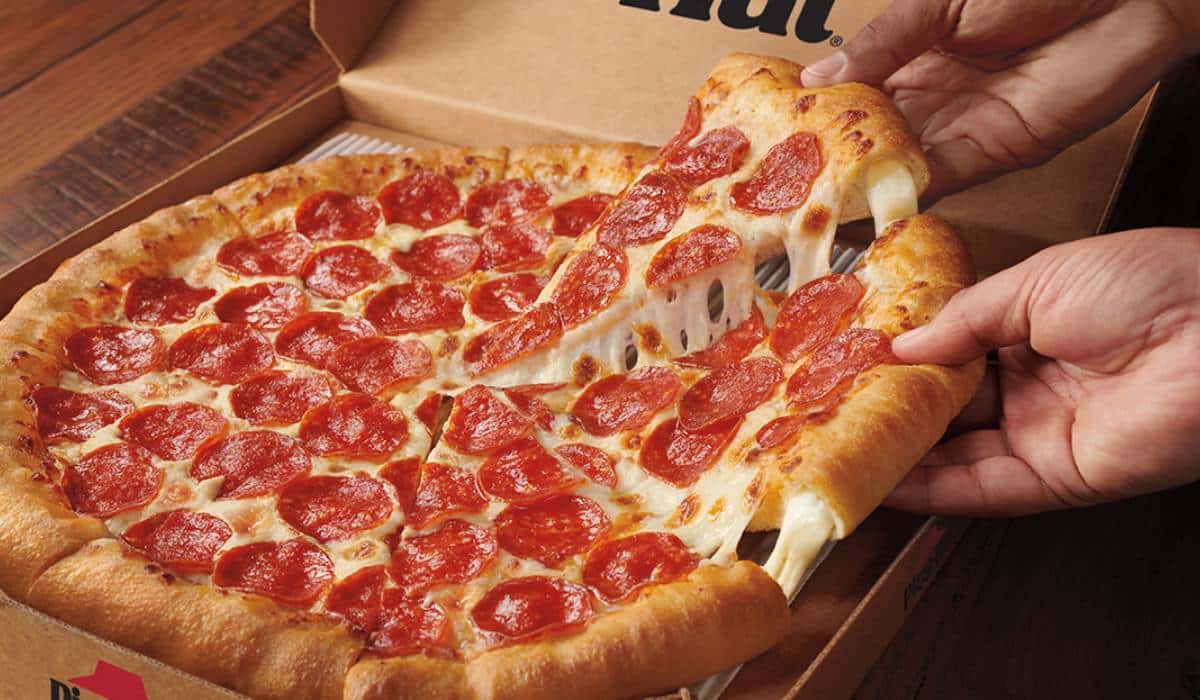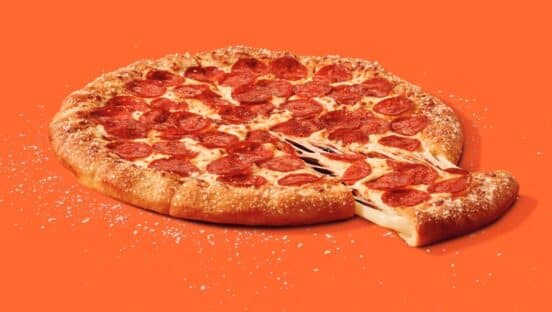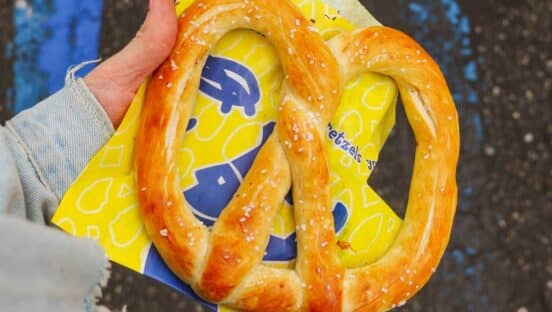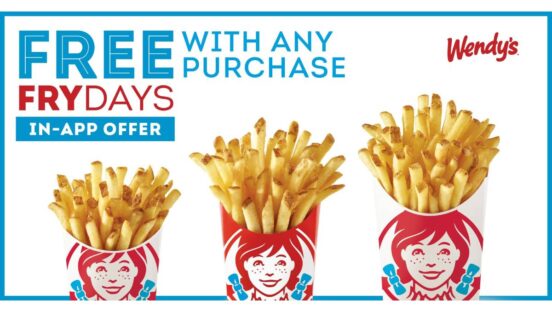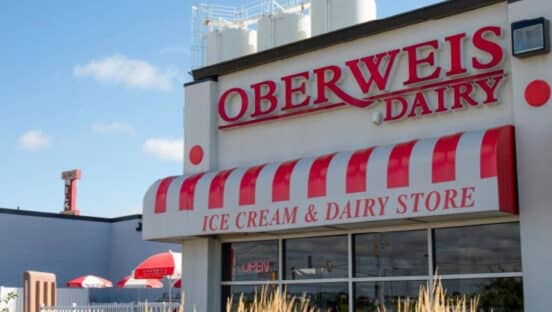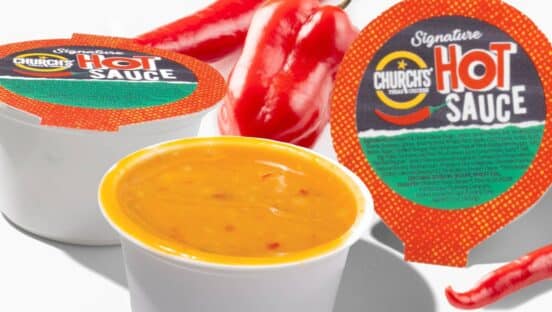Kevin Hochman’s Pizza Hut playbook had grown to eight pages of notes. Yes, the system needed to evolve from a dine-in, “red roof” footprint to one with more carryout, delivery friendly “delco” stores. And improving four-wall economics was step one. But much of what Hochman jotted down rang familiar throughout the halls of Yum! Brands HQ. The KFC U.S. president stepped into Pizza Hut’s comeback project in winter 2020. With the chicken giant, he directed a “Re-Colonelization” plan that reexamined KFC through the lens of infusing life into an iconic chain, not shaking it up and starting anew. The company invested 100,000 hours of training on “colonel standards” and brought KFC’s quality back to the level people remembered.
For Pizza Hut, it boiled down to an elementary question with a complex answer, and one not so different from KFC’s quandary. “When we were at our best, why was this brand so special?” Hochman says.
Hochman and David Graves, who also came over from KFC, where he served as director of marketing strategy and innovation, started searching for the answer at the birthplace of Pizza Hut’s journey. Along with franchisees, they explored the Pizza Hut Museum, housed in the original building where two Wichita State students, brothers Dan and Frank Carney, founded the chain in 1958. It kicked off a three-month “listening tour” across the map. Among the operational hurdles and real estate challenges Pizza Hut had to address, the brand simply needed a compass again.
“And that’s when we came up with this North Star—the ‘Pizza Lover’s Pizza,’” Hochman says. “This idea that we want to position ourselves the way we’ve always been positioned when we’ve been successful.”
CHECK OUT LAST YEAR’S TRANSFORMATIONAL BRAND OF THE YEAR
Change has arrived quick and furious for Pizza Hut since, making it QSR’s Transformational Brand of the Year, and that character held intact throughout. It’s anchored menu innovation, a “Newstalgia” campaign, COVID-19 response tactics, and even the communication between franchisees and corporate.
Before delving deeper into Pizza Hut path back, let’s take a status check. When Hochman and Graves joined the brand’s turnaround, domestic same-store sales had just declined 4 percent in Q4, year-over-year. Yum! cautioned investors Pizza Hut’s U.S. fleet could drop as low as 7,000 locations, which amounted to roughly 500 closures in a 24-month window. Globally, the brand shuttered 1,745 restaurants in 2020 (it also opened 682) to end the fiscal year with 17,639 venues around the world—the lowest figure since Q3 2018.
The main reason Pizza Hut slid was to accelerate a stateside transition to an off-premises-focused base. In October 2018, the gap between dine-in sales and sales from delivery and carryout was significant, with both the U.S. and international seeing a roughly 10-point differential. About half of Pizza Hut’s sales flowed from dine-in. Within three to four years, the company expected that to drop to 25 percent. And in the U.S., the conversion was even more pronounced, as dine-in sales declined to less than 10 percent of total take.
To put it plainly, the vibe changed dramatically in 2020, and hasn’t let up. Pizza Hut’s U.S. division posted 2 percent same-store sales growth in Q3, announced in late October. Pulled back, it gave the brand an 8 percent two-year stack. And Pizza Hut’s off-premises channel was up 17 percent.
The “Hut Lane” sprung up in 1,500 restaurants essentially overnight.
Additionally, over the past year, Pizza Hut International drove a significant inflection in its unit growth, going from negative net expansion to opening nearly 200 net venues in just Q3, or more than 300 better than a year ago.
KFC, off its comeback goals, pieced together eight years of growth. Hochman thinks this two-year spurt for Pizza Hut is just the opening act, “both in building new stores and growing the comps of our existing stores.”
Hochman entered his role as Pizza Hut’s interim U.S. president with two aims—restore the chain’s relationship and trust with franchisees, and layer momentum into the business. He’s leaving it confident that framework is in place.
On January 1, Graves succeeded him as president and Hochman resumed full-time duties at KFC. These moves solidified leadership under Pizza Hut CEO Aaron Powell, a Kimberly-Clark veteran who joined in September to fill a spot vacated in April by now-Topgolf CEO Artie Starrs. Regardless of the structure, though, the key is Pizza Hut’s core has been set.
“What are the types of pizzas they think our customers want?” Hochman says of the blueprint. “What are the things that make Pizza Hut so darn special and helped it last so many decades? And then, construct a plan with the franchisees on how we’re going to contemporize that. How are we going to take this into the 21st century, both in terms of the pizzas we sell, how do we go to market and how do we advertise, and the transformation in a business that’s going to do more and more sales off-premises.”
“And that’s where we hatched the strategy of we wanted to become America’s favorite pizza again,” he adds.
Beyond the immaterial, what did this mean? “If you look at what we’ve done that’s powered our growth during 2020 and now during 2021, we have the all-star lineup of pizzas,” Graves says. “Pizza Hut invented Pan Pizza [1980]. It invented Stuffed Crust Pizza [1995]. We invented the Supreme Pizza [1977 as the Super Supreme Pizza]. We were actually able to tap back into that all-star lineup and really advertise them and that has excited customers about the different types of pizzas and experience you can have with Pizza Hut.” (On a side, Pizza Hut actually started with thin-crust pizza, not pan, much to contrary opinion. The now-famous pan product was created with thicker dough that would travel better as off-premises became a larger part of Pizza Hut’s model).
Graves’ point is exactly why the company started to lean aggressively into hallmark innovations again. And why it led with new ones, as it historically always did—such as Detroit Style Pizza, an early 2021 LTO that sold out in a couple of weeks. Graves says the item was a collaboration with franchisees that returned Pizza Hut to yet another pillar: the ability to democratize major pizza trends for the masses.
Dressed down, Graves says, the goal is to bring “pizzas that people who love pizza want” to market. And to do so at moments where it’s relevant.
One of the first things Hochman and Graves tackled was to refocus Pizza Hut’s promotional calendar to put guest favorites front-and-center. That included the return of its iconic, 24-piece “Big Dipper” in March 2020. On the innovation front, the chain introduced plant-based options with Beyond Meat that November.
“I think we have been on a journey of finding that balance of getting back to your roots but doing it in a modern twist,” says Pizza Hut CMO Lindsay Morgan.
How Pizza Hut is getting products to guests, however, is an example of where the intersection of nostalgia and modern have collided. The phrase “frictionless experience” has been in the restaurant dictionary as long as “fast food” has. But it’s webbed out of late out in myriad directions. For Pizza Hut, no matter how a guest wants to order, via phone app or website, the brand needed systems to run without a kink, Hochman says. Arguably, the pizza part was the easy and fluid angle. The frictionless tech, though, presented whitespace, Hochman says. “And that was really the start of how are we going to shift this business,” he says.
As noted, it was a plan already stirring from an asset standpoint. COVID just sent it into hyper drive. Pizza Hut claims it was the first national pizza chain to offer contactless pickup, which it did across America in mid-April 2020. The move came with new safety seals and by March, Pizza Hut fulfilled north of 50 million contactless orders via delivery and carryout.
The process, which speedily proliferated the sector, involved a customer pulling up, hitting a button on their phone, and having an employee run out and drop pizza in the trunk.
Eventually, it would lead the company to something else as well, which carries the potential to reset Pizza Hut’s convenience potential even further. At the end of March 2021, Yum! unveiled “The Hut Lane,” which is a dedicated digital order pickup window. Like Chipotle’s “Chipotlanes,” customers access the feature through Pizza Hut’s app or online (or by phone), and drive to a dedicated window. No orderboard. Zero friction. Get your pizza without opening the car door.
Unlike Chipotle, however, Pizza Hut was able to flip the switch in 1,500 locations overnight. All it had to do was power restaurants to be digitally enabled so users could access the feature through the ease of their preferred devices.
In fact, Pizza Hut already had drive-thru windows in many restaurants. But they did very little business because people weren’t digitally connected, Hochman says. Once contactless curbside uncovered the opportunity and introduced guests to new channels, Pizza Hut jumped. “People wanted the convenience of staying in their car, but they wanted the speed of the conventional [quick-service restaurant] drive-thru,” Hochman says. “We said, why wouldn’t we take our app and enable those drive-thru windows and make them ‘Hut Lanes?’”
It was a unique moment, he adds. Recently, Hochman observed a competitor touting the speed of curbside. “But curbside in most restaurants just is not as fast as being able to run in and grab your food and run out,” he says.
In other terms, curbside doesn’t offer two sides of today’s golden token: the convenience and safety of contactless carryout, yet at the speed of drive-thru. “And that is what the Hut Lane is,” Hochman says.
Hut Lanes popped up in freestanding stores (not part of a strip mall), as well as end caps. Flynn Restaurant Group, America’s largest franchise operator that assumed ownership of 937 Pizza Huts last year as part of a deal with NPC International, plans to prioritize The Hut Lane “in many of its stores” going forward, the company said.
“It’s incredibly convenient for the customer and it’s incredibly safe,” Hochman says. “And even most importantly, it’s incredibly fast. And that’s what our customer is demanding today.”
During COVID, Hut Lanes could be labeled a reaction to the rise of digital ordering and off-premises, Graves adds. But long-term, the feature will serve a convenient occasion that’s fast become table-stakes for the quick-serve loyalist. The demand for a rapid, frictionless carryout experience isn’t going to subside when the pandemic does.
Craig Robinson, best known for his role as Darryl Philbin in “The Office, has helped bring Pizza Hut’s “Newstalgia” campaign to life.
Hochman says Pizza Hut expects “most” or close to all, of its new non-inline builds to include Hut Lanes. “Because the franchisees see the value of it, too,” he says.
In general, Graves says, Pizza Hut’s comeback strategy can “stand the test of time” and become something far more lasting. It’s no secret why it worked during COVID and has continued gaining momentum during this stanza of the restaurant rebound. Brands that led with trust won when the chips were down. And Pizza Hut had no shortage of equity to tap into.
The company introduced a Big Dinner Box when students went back-to-school, the Triple Treat Box—a three-course bundle for families—and continues to innovate around the notion more consumers are using pizzas as meal replacements with at-home occasions on the rise.
From a footprint standpoint, it’s also vital, Hochman says, to realize dine-in, which mixes 10 percent of the company’s total business today, remains viable in a lot of markets. There’s a model for dine-in and delco to make money, he notes. In some stores, dine-in pushes upward of 30 percent of sales. “I would say the interventions that we made on the business in terms of within the four walls of your currently open Pizza Hut, those worked on both dine-in assets and delco assets,” Hochman says. “These are things like promoting profitable pizzas, having the right innovation program so we can get a higher return on marketing ROI. One of the things that I heard all around the country from team members was simplifying the operation and how we make pizzas easier for our team members to both train on the Pizza Hut brand as well as make pizzas more quickly with less steps.”
A focus on more premium pizzas, fewer discounts, simplification, innovation around the core, as well as promoting options you can only get from Pizza Hut (such as Stuffed Crust and Pan), have produced dramatic improvements, dine-in or delco.
However, going forward, as Pizza Hut gets back to “being an aggressive builder of restaurants,” Hochman says, you’ll see more and more delcos, “if not 100 percent.”
The franchisee relationship can’t be understated, either, Graves says. Adding profitability back into the business, naturally, generated interest among operators to build more stores. “When we talk to franchisees, they’re trying to figure out how to serve their customer,” he says. “Our goal is to give them a set of options to let them serve their customers.”
Andy Rosen, a franchisee and the CEO of CFL Pizza, says his locations produced some of the best quarterly sales results in the last 10 years. The reasons echoing much of what Graves and Hochman shared. “Over the past year and a half, the business has been focused on four key areas: redefining food innovation, providing convenient and safe delivery and carryout options, leaning into our iconic pizzas, and delivering value,” he says. “We’re building on the things that have made Pizza Hut so successful over the years, like our iconic pizzas, while implementing new strategies and key changes, like shifting our asset base from dine-in to delivery and carryout.”
“I’m most excited about the focus the brand is putting into our mobile app and the website to make both as frictionless as possible,” he continues. “I’m encouraged by the plan we have in place and I’m excited about where the roadmap takes us in 2022.”
Another point Rosen highlights is the aforementioned “Newstalgia” marketing push, which came to life with Craig Robinson, best known for his role as Darryl Philbin in “The Office.” Also, a limited-edition Pac-Man augmented reality game the brand put on a pizza box via QR code to help guests recreate the classic arcade experience from Pizza Huts of old.
A hint of the old, with a modern twist.
Pizza Hut CMO Lindsay Morgan, who ascended to the role in April from director of brand communications, says Robinson was somebody the brand internally tossed around as an example of the type of personality they’d like to lead the message. Eventually, they just asked him.
In commercials, he’s wearing Pizza Hut merchandise, living in the ultimate brand man cave with classic elements on display, like Tiffany lamps and BOOK IT! pens. The brand actually borrowed real artifacts from franchisees dating back to the 50s, 60s, and 70s.
Morgan agrees Pizza Hut’s revitalization bears similarities to KFC’s. “I think what really was unique and special about Pizza Hut is it’s this great heritage brand and so many people will talk about growing up at a Pizza Hut, working at a Pizza Hut, going there after a Little League game,” she says.
Pizza Hut dropped a limited-edition BOOK IT! shirt run and had to up inventory five different times on the same day, for instance. “We were just really caught by surprise at the love for some of those ‘newstalgic’ elements,” she says.
Bringing these memories into the future, however, has been the challenge—to remind guests without having it feel dated. An example: following the BOOK IT! Launch, Pizza Hut introduced its first Streetwear Collection in July, with items like track suits and Tiffany Lamp t-shirts. The Pac-Man activation was also an example of taking something old and putting a fresh twist on it, she says.
Pizza Hut got on TikTok with Oneya Johnson, known for his @angryreactions account that has over 23.5 million fans, and asked guests to share personalized $10 Tastemaker pizza recipes. The winner got their recipe online and the chain gave away a year’s worth of gift cards.
The effort produced twice the engagement Pizza Hut expected and drove website traffic up 75 percent on launch date. “People were really proud about partnering with an emerging channel, and doing it in a really authentic way,” Morgan says.
“I think we have been on a journey of finding that balance of getting back to your roots but doing it in a modern twist,” she adds. “… We’re going to continue with that same strategy of leaning back in a nostalgic way but doing it in a way that’s relevant and fresh for today.”

